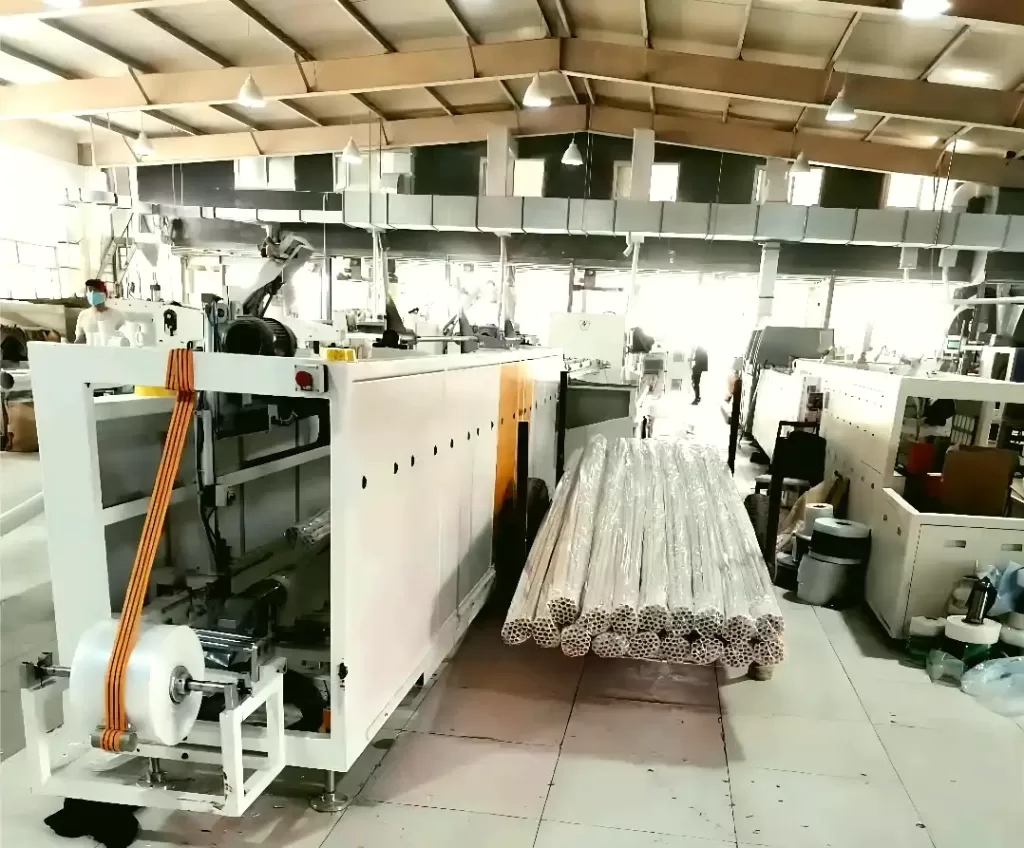Optimizing Pipe Handling: An Introduction to Automated UPVC and HDPE Pipe Bundle Packing Machines
Handling and packaging long lengths of unplasticized polyvinyl chloride (UPVC) and high-density polyethylene (HDPE) pipes efficiently and safely presents a significant challenge in manufacturing environments. Manual bundling is often labor-intensive, inconsistent, and can lead to product damage or worker strain. Automated pipe bundle packing machines offer a robust solution, streamlining the process from extrusion line to shipment. This guide provides an overview of these systems, their operation, benefits, and key considerations for implementation.
What is an Automated Pipe Bundle Packing Machine?
An automated pipe bundle packing machine, also referred to as an automatic pipe bundling system or plastic pipe packaging machine, is specialized industrial equipment designed to count, collect, arrange, and secure batches of UPVC or HDPE pipes into stable, transport-ready bundles. These systems typically integrate seamlessly with pipe extrusion or processing lines, automating the final packaging stage.
Key Components and Operational Flow
While specific designs vary, most automated pipe bundling systems consist of several core components working in sequence:
- Infeed Conveyor: Receives pipes individually from the upstream process (e.g., cutter or belling machine). Conveyors are designed to handle pipe lengths gently without causing scratches or damage.
- Pipe Collection & Counting: Pipes are collected in a designated area. Sensors or mechanical counters track the number of pipes until the pre-set bundle quantity is reached.
- Alignment & Arrangement: Mechanisms ensure pipes are properly aligned (often nested in hexagonal or square configurations) to form a compact and stable bundle shape. This optimizes space and ensures bundle integrity.
- Bundling Station: This is the core of the machine where the bundle is secured. Common methods include:
- Automatic Strapping: Applies polypropylene (PP) or polyester (PET) straps around the bundle at predetermined intervals. High-strength straps provide excellent holding power without deforming the pipes.
- Stretch Wrapping: Encases the bundle in layers of stretch film for containment and protection against dust and moisture.
- Outfeed System: Transports the completed bundle away from the machine, often onto roller conveyors, stacking systems, or directly to a palletizing area.
- Control System (PLC): Programmable Logic Controllers (PLCs) manage the entire sequence, coordinating sensors, motors, and actuators for reliable, automated operation. HMIs (Human-Machine Interfaces) allow operators to set parameters (bundle count, strap positions) and monitor the system.
- (Optional Video Placement: See a System in Action)
<iframe width="940" height="535" src="https://www.youtube.com/embed/VIDEO_ID_HERE_1" frameborder="0" allow="accelerometer; autoplay; clipboard-write; encrypted-media; gyroscope; picture-in-picture; web-share" referrerpolicy="strict-origin-when-cross-origin" allowfullscreen></iframe>
Types of Pipe Bundling Technologies
The choice of bundling technology often depends on the specific requirements for bundle security, protection, and downstream handling:
Automatic Strapping Machines: Widely used for their speed and the rigidity they impart to the bundle. Ideal for ensuring bundles maintain their shape during handling and storage. Polypropylene straps are common for UPVC and HDPE due to their balance of strength and flexibility.
Orbital Stretch Wrapping Systems: Provide excellent load containment and protection from environmental factors. The film conforms tightly to the bundle shape. Often used when additional protection or unitization is required.
Hybrid Systems: Some solutions may combine strapping for rigidity with a light wrap for protection or vice-versa, depending on the application needs.
(Optional Video Placement: Strapping vs. Wrapping Demonstration)
<iframe width="940" height="535" src="https://www.youtube.com/embed/VIDEO_ID_HERE_2" frameborder="0" allow="accelerometer; autoplay; clipboard-write; encrypted-media; gyroscope; picture-in-picture; web-share" referrerpolicy="strict-origin-when-cross-origin" allowfullscreen></iframe>
Benefits of Automated Pipe Bundling
Implementing an automated pipe packaging system offers numerous advantages for pipe manufacturers:
- Increased Throughput: Machines operate significantly faster and more consistently than manual methods, increasing overall production output.
- Improved Bundle Quality: Automation ensures consistent bundle counts, shapes, and strap/wrap tension, leading to more stable and uniform bundles.
- Reduced Labor Costs: Frees up personnel previously assigned to manual bundling for other value-added tasks.
- Enhanced Worker Safety: Eliminates repetitive manual lifting and handling of heavy, awkward pipes, reducing the risk of musculoskeletal injuries.
- Minimized Product Damage: Gentle handling mechanisms and secure bundling reduce scratches, deformation, and breakage during packaging and transport.
- Optimized Material Usage: Precise application of strapping or film minimizes waste compared to manual methods.
Selecting the Right Pipe Bundling System
Choosing the appropriate automated system requires careful consideration of several factors:
- Pipe Specifications: Diameter range, length variations, and material type (UPVC, HDPE, CPVC, etc.).
- Throughput Requirements: Desired bundles per hour or pipes per minute to match production line speed.
- Bundle Configuration: Required number of pipes per bundle, desired shape (hexagonal, square), and number/placement of straps or wrap layers.
- Level of Automation: Degree of integration needed with upstream and downstream equipment (e.g., automatic size changeovers, data logging).
- Space Availability: Footprint of the machine and required clearances within the facility layout.
- Environmental Conditions: Considerations for dust, temperature, or moisture in the operating environment.
- Budget: Initial investment cost versus long-term savings in labor, efficiency, and material usage.
For specific applications, such as packaging smaller components or accessories, dedicated systems may be necessary. Options exist for:
- PVC piping accessories packaging system
- HDPE piping accessories packaging system

automatic pipe bagging machine for pvc and ppr Integration and Maintenance Considerations
Successful implementation involves more than just purchasing the machine:
- Layout Planning: Careful integration into the existing production flow is crucial for maximizing efficiency.
- Operator Training: Ensuring personnel are properly trained on operation, parameter setting, and basic troubleshooting.
- Preventive Maintenance: Adhering to the manufacturer's recommended maintenance schedule (lubrication, inspections, wear part replacement) is vital for long-term reliability and performance. Common wear parts often include strap guides, cutter blades, and conveyor belts.
Conclusion
Automated UPVC and HDPE pipe bundle packing machines are essential tools for modern pipe manufacturers seeking to improve efficiency, ensure consistent product quality, enhance worker safety, and reduce operational costs. By carefully evaluating production needs and system capabilities, manufacturers can select and implement solutions that provide significant returns on investment and streamline their end-of-line packaging operations. Exploring various packaging solutions available can provide further insights into optimizing these processes. You can explore further information on packaging systems at www.fhopepack.com.
